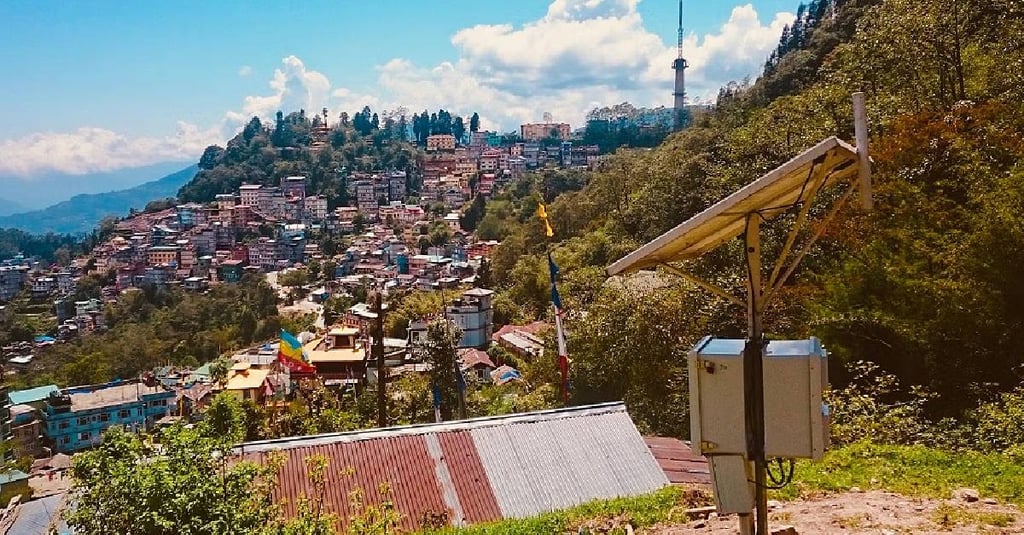Sikkim sets new standard in safety and sustainable development
As India struggles with the increasing frequency of climate-induced disasters, Sikkim’s proactive measures offer a roadmap for the future.
LOCAL


Sikkim has long been celebrated for its breathtaking landscapes, vibrant cultural heritage and pioneering status as India’s first fully organic state. Now, this small but dynamic state is carving out a new legacy as a national leader in disaster preparedness and resilience, as highlighted in a Press Information Bureau (PIB) release detailing a transformative disaster management initiative by the Ministry of Home Affairs. Sikkim’s innovative strategies, community-driven efforts and seamless integration of modern technology with traditional wisdom are positioning it as a model for disaster-prone regions across India, particularly in the Northeast.
Sikkim’s geography, while a boon for tourism and biodiversity, presents formidable challenges. The state’s rugged terrain, steep slopes, and proximity to seismic zones make it susceptible to natural calamities such as earthquakes, landslides, and flash floods. Monsoon seasons often bring heavy rainfall, triggering disruptions in connectivity and posing risks to lives and livelihoods. The PIB release underscores that Sikkim’s proactive approach to these challenges has made it a focal point in the Ministry’s nationwide push to strengthen disaster response mechanisms.
The initiative, launched in collaboration with the National Disaster Management Authority (NDMA) states the need for region-specific strategies to address India’s diverse disaster risks. For Sikkim, this translates into a tailored framework that leverages its unique strengths, community fortitude, environmental consciousness and strategic governance to create a robust defense against natural calamities.
At the heart of Sikkim’s success is its State Disaster Management Authority (SDMA), which has worked tirelessly to implement cutting-edge solutions. According to the PIB release, Sikkim has adopted advanced early warning systems, including satellite-based monitoring and real-time weather alerts delivered via mobile networks. These technologies ensure that even remote villages receive timely information about impending risks, enabling swift evacuations and preparedness measures.
“Sikkim’s approach is a blend of innovation and tradition,” noted a senior NDMA official in the PIB statement. The state has integrated indigenous knowledge—such as local communities’ understanding of weather patterns and terrain—into modern disaster management frameworks. For instance, in areas like Mangan and Chungthang, traditional practices of terraced farming and water conservation have been combined with scientific landslide mitigation techniques, reducing the impact of soil erosion during heavy rains.
Community participation forms the cornerstone of Sikkim’s strategy. The SDMA has conducted extensive training programs and mock drills across districts, empowering residents to respond effectively during crises. In villages like Lachung and Namchi, local volunteers have been trained as first responders, equipped with basic rescue kits and communication tools. These efforts have fostered a culture of self-reliance, ensuring that communities are not solely dependent on external aid during emergencies.
The PIB release highlights significant central funding allocated to Sikkim for infrastructure upgrades, a critical component of its disaster resilience strategy. Roads and bridges, often washed away during monsoons, are being reinforced with climate-resilient designs. Emergency shelters equipped with solar-powered lighting and water harvesting systems are being established in vulnerable areas, ensuring safety and sustainability. These upgrades are not only vital for disaster response but also bolster Sikkim’s tourism-driven economy.
Tourism, a lifeline for Sikkim, attracts millions annually to destinations like Tsomgo Lake, Pelling, and Nathula Pass. However, frequent landslides and road blockages have posed challenges to accessibility. The new infrastructure investments aim to ensure year-round connectivity, making these iconic sites safer for visitors. Additionally, the state’s commitment to eco-friendly tourism aligns with its disaster management ethos, as sustainable practices like organic farming and waste management reduce environmental degradation that exacerbates natural disasters.
Sikkim’s status as India’s first 100% organic state is moreorgan than a badge of honor; it’s a philosophy that permeates its disaster management approach. By prioritizing sustainable land use and environmental conservation, Sikkim has reduced vulnerabilities associated with deforestation and soil degradation. The PIB release notes that the state’s organic farming practices, which avoid chemical fertilizers and promote biodiversity, have strengthened soil stability, mitigating landslide risks in hilly areas.
The state’s Green Mission, launched over a decade ago, has also contributed to its resilience. Afforestation drives and watershed management programs have restored ecosystems, ensuring better water retention during monsoons and reducing flood risks. These efforts have earned Sikkim praise from the NDMA, which views the state as a case study for integrating environmental sustainability with disaster preparedness.
The state’s efforts have not gone unnoticed. The NDMA has lauded Sikkim for its “exemplary coordination” between local, state, and central agencies, a model that other states are now encouraged to emulate. This recognition underscores Sikkim’s growing stature as a leader in the Northeast, a region critical to India’s strategic and ecological landscape.
As India struggles with the increasing frequency of climate-induced disasters, Sikkim’s proactive measures offer a roadmap for the future. The state’s ability to balance development with environmental stewardship, coupled with its community-driven disaster management model, sets it apart as a beacon of resilience. The PIB initiative highlights Sikkim’s potential to inspire other hilly states like Himachal Pradesh and Uttarakhand, where similar geographic challenges persist.
Looking ahead, Sikkim plans to expand its disaster management framework by incorporating artificial intelligence for predictive analytics and expanding training programs to include urban areas like Gangtok. These efforts will further strengthen the state’s ability to respond to crises while preserving its natural and cultural heritage.
Sikkim, often called the “Land of Kanchenjunga,” is proving that small states can make a big impact. Its role in the national disaster management initiative, as detailed in the PIB release, showcases a harmonious blend of tradition, technology and tenacity.
